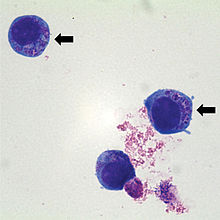
Back عدوى المحببات البشرية بالإيرليخية Arabic Humane Granulozytäre Anaplasmose German Anaplasmosis granulocítica humana Spanish Inimese granulotsütaarne anaplasmoos ET Anaplasmose humaine French ヒト顆粒球アナプラズマ症 Japanese Anaplazmoza Polish Гранулоцитарний анаплазмоз людини Ukrainian 人粒细胞无形体病 Chinese
| Human granulocytic anaplasmosis | |
|---|---|
| Other names | Human granulocytic ehrlichiosis (HGE)[1][2] |
 | |
| Anaplasma phagocytophilum cultured in a human promyelocytic cell line, arrows point to cells containing prominent bacterial morulae | |
| Specialty | Infectious diseases |
Human granulocytic anaplasmosis (HGA) is a tick-borne, infectious disease caused by Anaplasma phagocytophilum, an obligate intracellular bacterium that is typically transmitted to humans by ticks of the Ixodes ricinus species complex, including Ixodes scapularis and Ixodes pacificus in North America. These ticks also transmit Lyme disease and other tick-borne diseases.[3]
The bacteria infect white blood cells called neutrophils, causing changes in gene expression that prolong the life of these otherwise short-lived cells.[4]
- ^ Malik A, Jameel M, Ali S, Mir S (2005). "Human granulocytic anaplasmosis affecting the myocardium". J Gen Intern Med. 20 (10): C8–10. doi:10.1111/j.1525-1497.2005.00218.x. PMC 1490240. PMID 16191146.
- ^ "Human Anaplasmosis Basics - Minnesota Dept. of Health". Archived from the original on 2018-03-14. Retrieved 2009-04-13.
- ^ Holden, K.; Boothby, J. T.; Anand, S.; Massung, R. F. (2003). "Browse BioOne Complete". Journal of Medical Entomology. 40 (4): 534–9. doi:10.1603/0022-2585-40.4.534. ISSN 0022-2585. PMID 14680123.
- ^ Lee HC, Kioi M, Han J, Puri RK, Goodman JL (September 2008). "Anaplasma phagocytophilum-induced gene expression in both human neutrophils and HL-60 cells". Genomics. 92 (3): 144–51. doi:10.1016/j.ygeno.2008.05.005. PMID 18603403.